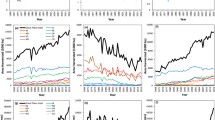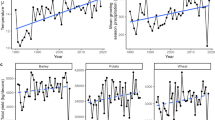Abstract
We analyze the response of Kenyan maize yields to near-term climate change and explore potential mitigation options. We model county level yields as a function of rainfall and temperature during a period of increased regional warming and drying (1989–2008). We then do a counter factual analysis by comparing existing maize yields from 2000 to 2008 to what yields might have been if observed warming and drying trends had not occurred. We also examine maize yields based on projected 2026–2040 climate trends. Without the observed warming and drying trends, Eastern Kenya would have had an 8% increase in maize yields, which in turn would have led to a net production increase of 500,000 metric tons. In Western Kenya, the magnitude of change is higher but the relative changes in predicted values are smaller. If warming and drying trends continue, we expect future maize yields to decline by 11% in Eastern Kenya (vs. 7% in Western Kenya). We also examine whether these future losses might be offset through agricultural development. For that analysis, we use a household panel dataset (2000, 2005) with measurements of individual farm plot yields, inputs, and outputs. We find that under a scenario of aggressive adoption of hybrid seeds and fertilizer usage coupled with warming and drying trends, yields in Western Kenya might increase by 6% while those in Eastern Kenya could increase by 14%. This increase in yields might be larger if there is a corresponding increase in usage of drought-tolerant hybrids. However, wide prediction intervals across models highlight the uncertainty in these outcomes and scenarios.



Similar content being viewed by others
Notes
We discuss the causes and evidence for this trend at length in section 1 (SP1) of the online supplemental material.
We do not have accurate data for 2006.
While data are collected at the farmer level, the division is the finest resolution at which we are able to geocode. The division is an administrative unit below the district. The yields used in the macro analysis are reported at the district level.
The growth in yields estimated by Ariga and Jayne (2010) is higher than those given by official government statistics. Reasons for the difference in estimates are discussed in that paper.
References
Abate T, Shiferaw B, Menkir A, Wegary D, Kebede Y, Tesfaye K, Kassie M, Bogale G, Tadesse B, Keno T (2015) Factors that transformed maize productivity in Ethiopia. Food Sec 7:965–981
Ainembabazi JH, van Asten P, Vanlauwe B, Ouma E, Blomme G, Birachi EA, Nguezet PMD, Mignouna DB, Manyong VM (2016) Improving the speed of adoption of agricultural technologies and farm performance through farmer groups: evidence from the Great Lakes region of Africa. Agricultural Economics, n/a-n/a
Argwings-Kodhek G, Kiiru MW, Tschirley D, Ochieng BA, Landan BW (2000) Measuring income and the potential for poverty reduction in rural Kenya. Nakuru: Egerton University, Tegemeo Institute of Agricultural Policy and Development TAMPA
Ariga J, Jayne TS, (2010) Factors driving the increase in fertilizer use by smallholder farmers in Kenya, 1990–2007. World Bank
Bänziger M, Edmeades GO, Lafitte HR (1999) Selection for drought tolerance increases maize yields across a range of nitrogen levels. Crop Sci 39(4):1035–1040
Bänziger M, Edmeades GO, Lafitte HR (2002) Physiological mechanisms contributing to the increased N stress tolerance of tropical maize selected for drought tolerance. Field Crop Res 75(2):223–233
Bezemer D, Headey D (2008) Agriculture, development, and urban bias. World Dev 36:1342–1364
Bot A and Benites J (2005) Drought-resistant soils: optimization of soil moisture for sustainable plant production: Proceedings of the Electronic Conference Organized by the FAO Land and Water Development Division, Food & Agriculture Org
Chen B-L, Liao S-Y (2015) The role of agricultural productivity on structural change. Rev Dev Econ 19:971–987
Davenport F, Husak G, Jayanthi H (2015) Simulating regional grain yield distributions to support agricultural drought risk assessment. Appl Geogr 63:136–145
Davenport F, Grace K, Funk C, Shukla S (2017) Child health outcomes in sub-Saharan Africa: a comparison of changes in climate and socio-economic factors. Glob Environ Chang 46:72–87
Diao X, Hazell P, Thurlow J (2010) The role of agriculture in African development. World Dev 38:1375–1383
Droppelmann KJ, Snapp SS, Waddington SR (2017) Sustainable intensification options for smallholder maize-based farming systems in sub-Saharan Africa. Food Sec 9(1):133–150
Duflo E, Kremer M, Robinson J (2008) How high are rates of return to fertilizer? Evidence from field experiments in Kenya. Am Econ Rev 98:482–488
Duflo E, Kremer M, Robinson J (2011) Nudging farmers to use fertilizer: theory and experimental evidence from Kenya. Am Econ Rev 101:2350–2390
FAOSTAT (2015) FAOSTAT
Funk CC, Brown ME (2006) Intra-seasonal NDVI change projections in semi-arid Africa. Remote Sens Environ 101:249–256
Funk C, Brown M (2009) Declining global per capita agricultural production and warming oceans threaten food security. Food Sec 1:271–289
Funk C, Dettinger MD, Michaelson J, Verdin J, Brown ME (2008) The warm ocean dry Africa dipole controls decadal moisture transports threatening food insecure Africa. Proc Natl Acad Sci 105:11081–11086
Funk C, Hoell A, Shukla S, Bladé I, Liebmann B, Roberts JB, Robertson FR, Husak G (2014) Predicting East African spring droughts using Pacific and Indian Ocean sea surface temperature indices. Hydrol Earth Syst Sci 18:4965–4978
Funk C, Nicholson SE, Landsfeld M, Klotter D, Peterson P, Harrison L (2015a) The Centennial Trends Greater Horn of Africa precipitation dataset. Scientific Data 2
Funk C, Peterson P, Landsfeld M, Pedreros D, Verdin J, Shukla S, Husak G, Rowland J, Harrison L, Hoell A (2015b) The climate hazards infrared precipitation with stations—a new environmental record for monitoring extremes. Scientific data 2
Funk C, Shukla S, Hoell A, Livneh B (2015c) Assessing the contributions of East African and west Pacific warming to the 2014 boreal spring East African drought. Bull Am Meteorol Soc 96:S77–S82
Funk C, Verdin A, Michaelsen J, Peterson P, Pedreros D, Husak G (2015d) A global satellite assisted precipitation climatology. Earth Syst Sci Data Discuss 7:1–13
Funk C, Davenport F, Harrison L, Magadzire T, Galu G, Artan G, Shukla S, Korecha D, Indeje M, Pomposi C, Macharia D, Husak G (2017) Anthropogenic enhancement of moderate-to-strong El Niños likely contributed to drought and poor harvests in Southern Africa during 2016. Bull Am Meteorol Soc 37:S1–S3. https://doi.org/10.1175/BAMS-D-17-0112.2
Gollin D, Parente S, Rogerson R (2002) The role of agriculture in development. Am Econ Rev 92:160–164
Grace K, Davenport F, Funk C, Lerner AM (2012) Child malnutrition and climate in Sub-Saharan Africa: an analysis of recent trends in Kenya. Appl Geogr 35:405–413
Grace K, Davenport F, Hanson H, Funk C, Shukla S (2015) Linking climate change and health outcomes: examining the relationship between temperature, precipitation and birth weight in Africa. Glob Environ Chang 35:125–137
Hansen JW, Indeje M (2004) Linking dynamic seasonal climate forecasts with crop simulation for maize yield prediction in semi-arid Kenya. Agric For Meteorol 125:143–157
Harris I, Jones PD, Osborn TJ, Lister DH (2014) Updated high-resolution grids of monthly climatic observations—the CRU TS3.10 dataset. Int J Climatol 34:623–642
Hatfield JL, Prueger JH (2015) Temperature extremes: effect on plant growth and development. Weather Clim Extremes 10(Part A):4–10
Hicks DR, Thomison PR (2004) Corn management, in: Smith CW, Beltran J, Runge ECA (Eds), Corn: origin, history, technology, and production. Wiley, pp. 481–522
Jose VRR, Winkler RL (2008) Simple robust averages of forecasts: some empirical results. Int J Forecast 24:163–169
Li G, Zhao B, Dong S, Zhang J, Liu P, Vyn TJ (2017) Impact of controlled release urea on maize yield and nitrogen use efficiency under different water conditions. PLoS One 12(7):e0181774
Lobell DB, Bänziger M, Magorokosho C, Vivek B (2011) Nonlinear heat effects on African maize as evidenced by historical yield trials. Nat Clim Chang 1:42–45
Magrini E, Vigani M (2016) Technology adoption and the multiple dimensions of food security: the case of maize in Tanzania. Food Sec 8:707–726
Makridakis S (1983) Averages of forecasts: some empirical results. Manag Sci 29:987–996
Makridakis S, Wheelwright S, Hyndman R (1998) Forecasting: methods and applications
Mason NM, Wineman A, Kirimi L, Mather D (2017) The effects of Kenya’s ‘smarter’ input subsidy programme on smallholder behaviour and incomes: do different quasi-experimental approaches lead to the same conclusions? J Agric Econ 68:45–69
Novick K, Williams C, Phillips R, Oishi A, Sulman B, Bohrer G and Ficklin D (2015). Vapor pressure deficit is as important as soil moisture in determining limitations to evapotranspiration during drought. AGU Fall Meeting Abstracts
Nyakudya IW, Stroosnijder L (2011) Water management options based on rainfall analysis for rainfed maize (Zea mays L.) production in Rushinga district, Zimbabwe. Agric Water Manag 98(10):1649–1659
Salasya B, Mwangi W, Mwabu D, Diallo A (2007) Factors influencing adoption of stress-tolerant maize hybrid (WH 502) in western Kenya. Afr J Agric Res 2(10):544–551
Schlenker W, Roberts MJ (2009) Nonlinear temperature effects indicate severe damages to US crop yields under climate change. Proc Natl Acad Sci 106:15594–15598
Sheffield J, Goteti G, Wood EF (2006) Development of a 50-year high-resolution global dataset of meteorological forcings for land surface modeling. J Clim 19:3088–3111
Short C, Mulinge W, Witwer M, (2012) Analysis of incentives and disincentives for maize in Kenya, in: FAO (Ed), Technical Notes Series MAFAP. FAO, Rome
Slegers MFW, Stroosnijder L (2008) Beyond the desertification narrative: a framework for agricultural drought in semi-arid East Africa. AMBIO 37(5):372–380
Smale M and Olwande J (2011). Is older better?: Maize hybrid change on household farms in Kenya, Michigan State University, Department of Agricultural, Food, and Resource Economics and Department of Economics
Stroosnijder L (2007) Rainfall and land degradation. Climate and land degradation. M. V. K. Sivakumar and N. Ndiang’ui. Springer Berlin Heidelberg, Berlin, Heidelberg, pp 167–195
Stroosnijder L (2009) Modifying land management in order to improve efficiency of rainwater use in the African highlands. Soil Tillage Res 103(2):247–256
Westgate M E, Otegui M, Andrade FH, (2004) Physiology of the corn plant, in: Smith CW, Betrán J, Runge ECA (Eds), Corn: origin, history, technology, and production. Wiley, pp. 235–272
Wood S (2007) The mgcv package. www.r-project.org
Acknowledgments
This work was primarily supported by USGS cooperative agreement #G14AC00042 and NASA grant #NNX16AM02G. Chris Funk is supported under the USGS Drivers of Drought program. Sari Blakeley provided valuable feedback on an earlier version of this paper. We also thank the three anonymous reviewers for their comments and critiques. Any use of trade, firm, or product names is for descriptive purposes only and does not imply endorsement by the U.S. Government.
Author information
Authors and Affiliations
Corresponding author
Electronic supplementary material
ESM 1
(DOCX 8389 kb)
Rights and permissions
About this article
Cite this article
Davenport, F., Funk, C. & Galu, G. How will East African maize yields respond to climate change and can agricultural development mitigate this response?. Climatic Change 147, 491–506 (2018). https://doi.org/10.1007/s10584-018-2149-7
Received:
Accepted:
Published:
Issue Date:
DOI: https://doi.org/10.1007/s10584-018-2149-7




